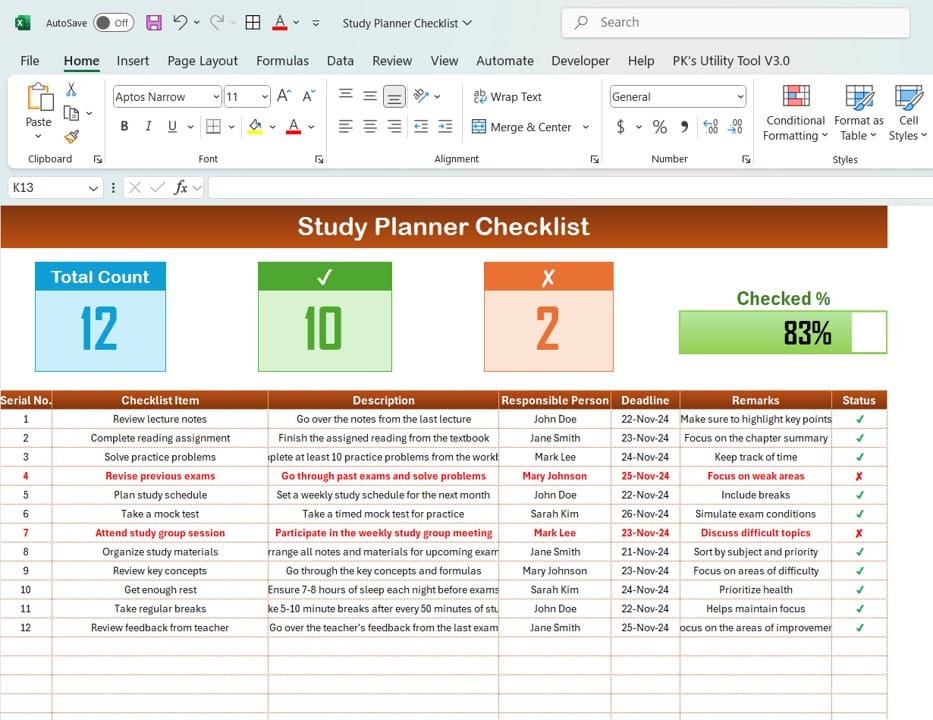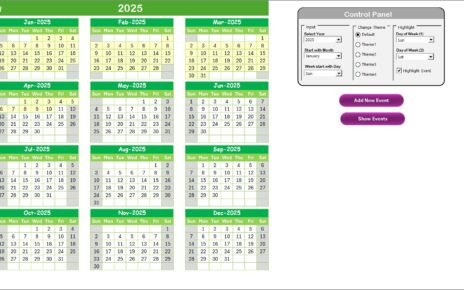In today’s fast-paced world, staying organized is crucial to achieving academic success. With so many tasks to juggle, students and professionals alike often feel overwhelmed by the amount of work ahead of them. A Study Planner Checklist can help you stay on track and ensure that nothing falls through the cracks. Whether you are preparing for an exam, working on an assignment, or simply trying to manage your time more efficiently, this checklist is a tool you can rely on.
In this article, we will explore everything you need to know about creating a Study Planner Checklist, including its benefits, ways to improve it, best practices, and more.
Click to Study Planner
What is a Study Planner Checklist?
A Study Planner Checklist is a structured tool that helps you organize your study tasks, track deadlines, and manage your workload effectively. It provides a clear visual of all your academic tasks, breaking them down into manageable steps. Whether you’re preparing for a test, working through assignments, or planning your study schedule, a checklist helps you keep everything organized.
You can create a Study Planner Checklist in different formats, including on paper, in a spreadsheet, or via a study app. Regardless of the format, it’s designed to help you stay focused and organized, so you never lose track of what needs to be done.
Key Features of a Study Planner Checklist Template
A well-designed Study Planner Checklist template will typically include the following features:
- Study Planner Worksheet: This is the main section where you input all the checklist details, such as tasks, deadlines, and progress.
- Top Section: This area typically includes summary statistics, such as:
- Total Count of tasks
- Checked Count of completed tasks
- Crossed Count of failed or missed tasks
Progress Bar showing the percentage of tasks completed.
- Checklist Table: The heart of the planner, where you track each task’s details like description, responsible person, deadline, remarks, and status (whether completed or pending).
Breakdown of the Checklist Table Columns:
Here’s a quick look at the typical columns found in the checklist:
- Serial No.: The task’s identification number.
- Checklist Item: A brief description of the task.
- Description: A more detailed explanation of the task.
- Responsible Person: The individual assigned to complete the task.
- Deadline: The date by which the task should be completed.
- Remarks: Any important notes regarding the task.
- Status: A checkmark (✔) indicates a completed task, while a cross (✘) shows an incomplete task.

Click to Study Planner
Advantages of Using a Study Planner Checklist
There are many advantages to using a Study Planner Checklist. By organizing your tasks, you can make your study time more efficient and less stressful. Below are some of the key benefits:
- Better Organization: A checklist allows you to structure your tasks in a clear and logical way. This helps you stay organized and ensures you don’t forget any important assignments.
- Increased Accountability: When you assign tasks to yourself or others, you create a sense of responsibility. This helps ensure that all tasks are completed on time.
- Visual Progress Tracking: The progress bar and checkboxes give you a quick visual representation of your progress, motivating you to keep going.
- Time Management: A checklist helps you allocate time to specific tasks. This reduces the likelihood of procrastination and ensures you can tackle tasks efficiently.
- Reduced Stress: By breaking down tasks into smaller, manageable chunks, a checklist can help prevent feelings of overwhelm. It gives you a clear roadmap to follow, which reduces anxiety.
Opportunities for Improvement in the Study Planner Checklist
Although a Study Planner Checklist is an excellent tool, there is always room for improvement. Here are a few suggestions to make your checklist even more effective:
- Personalize It: Customize the checklist template according to your specific needs. If you’re preparing for exams, you could add columns for exam dates, subject names, or specific exam formats.
- Set Reminders: Incorporate automatic reminders for upcoming deadlines to ensure you stay on track. Many digital tools offer this feature.
- Include Study Breaks: Study sessions can be intense, so it’s important to include breaks. Scheduling regular intervals of rest will improve focus and productivity.
- Add Long-Term Goals: Including long-term academic goals alongside daily tasks helps you stay aligned with your larger objectives. It’s a great way to stay motivated and focused.
Best Practices for Creating a Study Planner Checklist
To maximize the effectiveness of your Study Planner Checklist, follow these best practices:
- Be Specific with Tasks: Rather than writing vague tasks like “study for the exam,” break it down into specific actions like “review Chapter 1 notes” or “complete practice problems from Section 2.”
- Set Realistic Deadlines: Avoid overloading your schedule. Be realistic about how much time you need for each task and set achievable deadlines.
- Prioritize Tasks: Not all tasks are equally important. Make sure to prioritize the most urgent or difficult tasks first, using color codes or numbers to indicate priority.
- Regularly Review the Checklist: Take time to review your checklist on a daily or weekly basis to stay updated on your progress. Adjust it as needed to keep things on track.
- Track Your Progress: Mark completed tasks with a checkmark, and use the status column to gauge your overall progress. This will keep you motivated and help you see how far you’ve come.
Frequently Asked Questions (FAQs)
- How do I create a Study Planner Checklist?
Creating a Study Planner Checklist is simple. Start by listing all the tasks you need to complete. Break them down into smaller, actionable steps, and assign deadlines. Organize these tasks in a table format with columns for task description, responsible person, deadline, and status. Finally, track your progress by checking off completed tasks.
- How can I improve my Study Planner Checklist?
Click to Study Planner
To improve your Study Planner Checklist, consider customizing it to suit your unique needs. You can add columns for goals, include study breaks, or integrate the checklist with calendar apps that send you reminders. This will make it easier to stay on top of your tasks.
- Why should I use a Study Planner Checklist?
A Study Planner Checklist helps you stay organized, manage your time effectively, and reduce stress. It ensures that no task is overlooked and helps you stay accountable to your academic goals.
- Can I share my Study Planner Checklist with others?
Yes, you can share your Study Planner Checklist with others, especially in group study situations. By doing so, you can collaborate, delegate tasks, and ensure everyone is on the same page regarding deadlines and responsibilities.
- What are the essential components of a Study Planner Checklist?
The essential components of a Study Planner Checklist include: Serial No., Checklist Item, Description, Responsible Person, Deadline, Remarks, and Status. These elements help keep track of your tasks and deadlines effectively.
Conclusion
In conclusion, a Study Planner Checklist is an essential tool for anyone looking to improve their study habits, stay organized, and achieve academic success. By following the tips and best practices outlined above, you can maximize your productivity, reduce stress, and make your study sessions more efficient. So, start today by creating your own checklist, and take control of your academic journey!
Visit our YouTube channel to learn step-by-step video tutorials
View this post on Instagram



